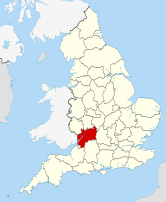Kingswood Abbey

Kingswood Abbey was a Cistercian abbey, located in the village of Kingswood near Wotton-under-Edge, Gloucestershire, England.
Through the abbey's gatehouse arch are a few houses and the small village primary school of Kingswood.
History
Kingswood Abbey was founded in 1139 by William of Berkeley, provost of Berkeley,[1] in accordance with the wishes of his late uncle, Roger II of Berkeley, and colonised from the Cistercian house at Tintern, Monmouthshire.[2] The founding family were the feudal barons of Dursley, who intermarried later with the progeny of Robert Fitzharding (d.1170), 1st feudal baron of Berkeley Castle.
In the mid-12th century the abbot and all but a few monks removed, first to Hasleden near Rodmarton and then, for want of water at that site, to Tetbury, Kingswood becoming a grange until the return of the community to "Mireford" in Kingswood, close to the earlier site.[3] According to the taxation of Pope Nicholas IV in 1291, annual spiritualities and temporalities came to £54 1s 6d, and at the time of the Dissolution of the Monasteries the abbey was variously valued at about £245.[4]
The replacement of the old abbot by a royal appointee in 1517 occasioned a riot in which the monks were joined by their neighbours: the displeasure of Edward Stafford, 3rd Duke of Buckingham, effected the restoration of order.[5] Henry VIII leased the monastery estate to the courtier Sir Nicholas Poyntz for a period of 21 years, and in 1559 Elizabeth granted it to Sir John Thynne, the builder of Longleat.[6]
The cellarer's and bursar's accounts that survive for 1240-41 (Cellarer's accounts) and 1241-2 (Bursar's accounts) may well be the earliest accounts of their kind now in existence,[7] but all that survives at the site today is the early 16th-century[8] abbey gatehouse (illustration), which is under the care of English Heritage.
Calcot Manor, a few miles to the northeast, was built as a tithe barn by the monks of the abbey. Forty-eight original charters of Kingswood Abbey, covering the years 1225 to 1444 and preserved in antiquarian collections, last went on sale at Sotheby's in 1945.[9]
References
- ^ Barkly, H, p.200
- ^ Archives Hub, 2006
- ^ John Caley et al, tr. and eds. Dugdale, William. Monasticon Anglicanum vol. 5 (1846) s.v. "Kingswood Abbey" 424ff.
- ^ Dugdale, eo loc; see also Lindley, E. S. "Kingswood Abbey, its lands and mills." Transactions of the Bristol and Gloucestershire Arch. Society, 73 (1955): 115-191.
- ^ Rawcliffe, Carole, The Staffords: Earls of Stafford and Dukes of Buckingham, 1394-1521 1978:98, quoting archives.
- ^ Dugdale 425.
- ^ Harvey, Barbara F. The Obedientiaries of Westminster Abbey and Their Financial Records 2002:xvi.
- ^ Alison, Judith et al, Tree-ring analysis of timbers from Kingswood Abbey Gatehouse, Kingswood, Gloucestershire (Centre for Archaeology report 21 2003.
- ^ Austin, Roland. "Kingswood Abbey charters", in Transactions of the Bristol and Gloucestershire Archaeological Society, 65 (1944:220) (pdf file); the charters were calendared in Historical Manuscripts Commission. vol. 5, and transcribed in Transactions of the Bristol and Gloucestershire Archaeological Society 22:178-256.
Bibliography
- Victoria County History, Gloucestershire, Vol.2, 1907, Houses of Cistercian monks: The Abbey of Kingswood, pp. 99–101
- Barkly, H. "The Earlier House of Berkeley" in Transactions of the Bristol and Gloucestershire Archaeological Society, Vol. 8, 1883-84' esp. pp 199–201
- Archives Hub profile: Kingswood Abbey
External links
- Kingswood Abbey Gatehouse, English Heritage
- Detailed historical record for Kingswood Abbey Gatehouse
- Kingswood Abbey papers 1225-1444 University of Bristol Library Special Collections
51°37′35″N 2°22′00″W / 51.62639°N 2.36667°W


